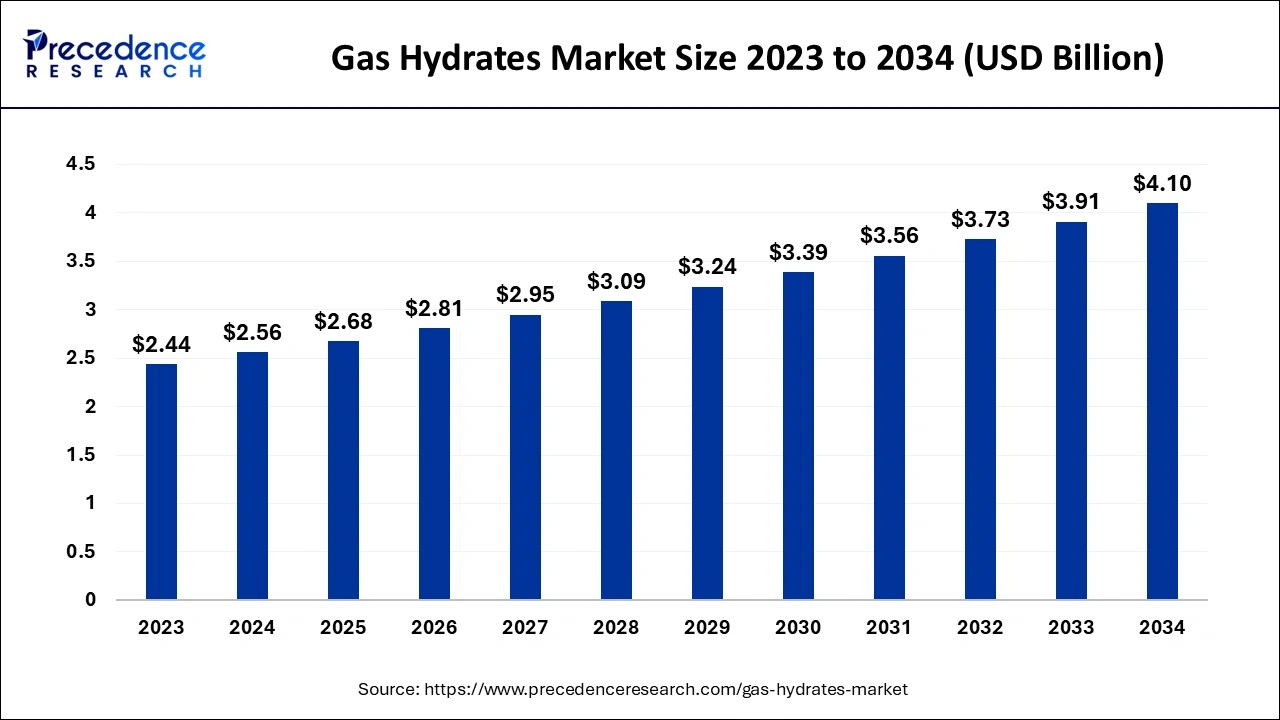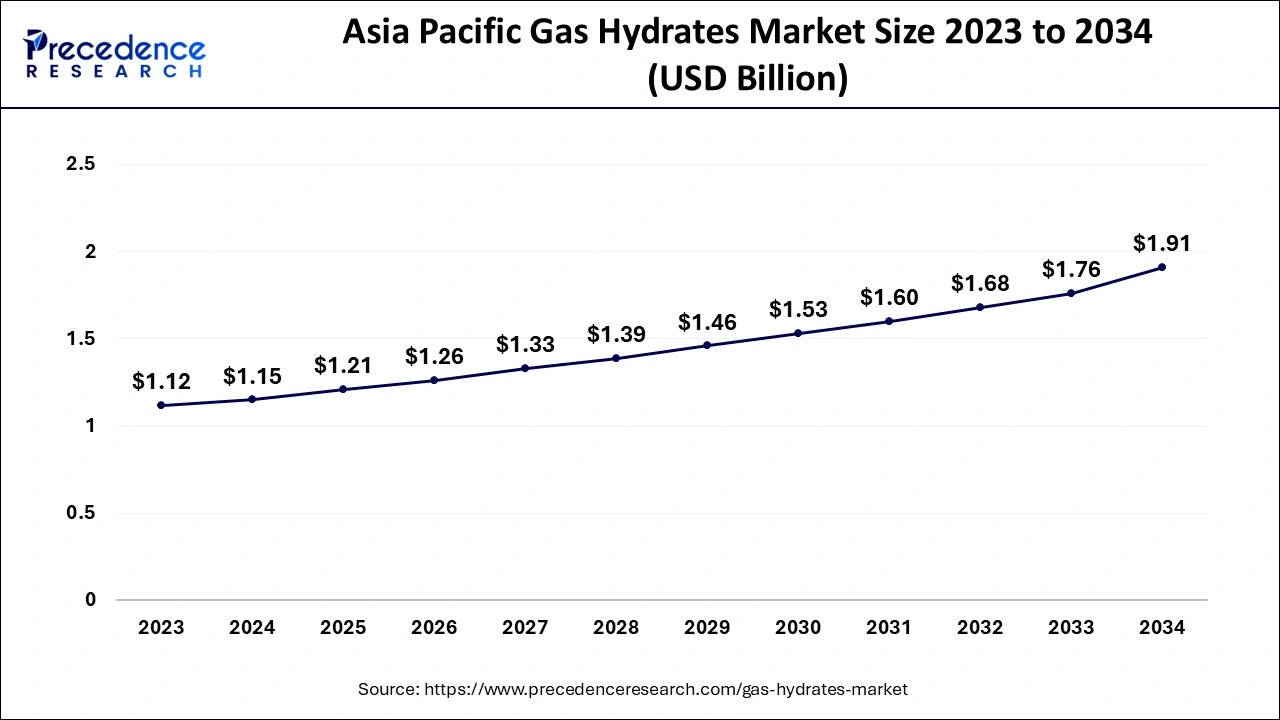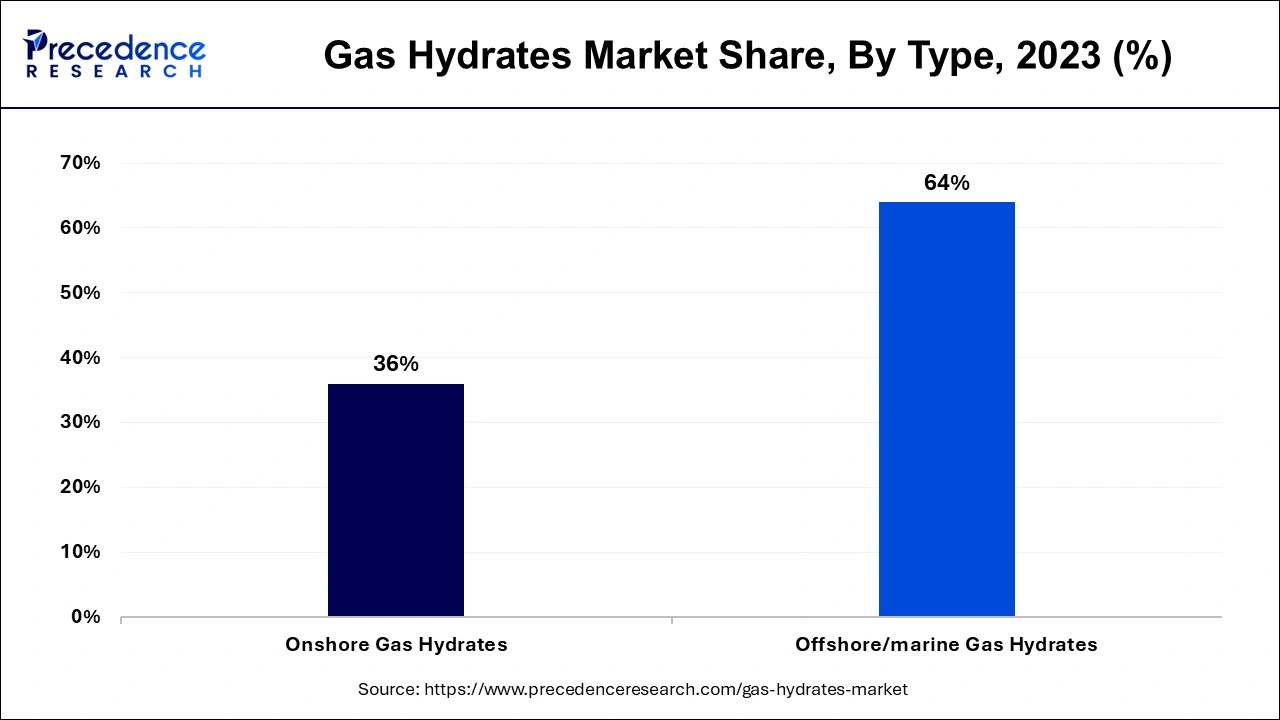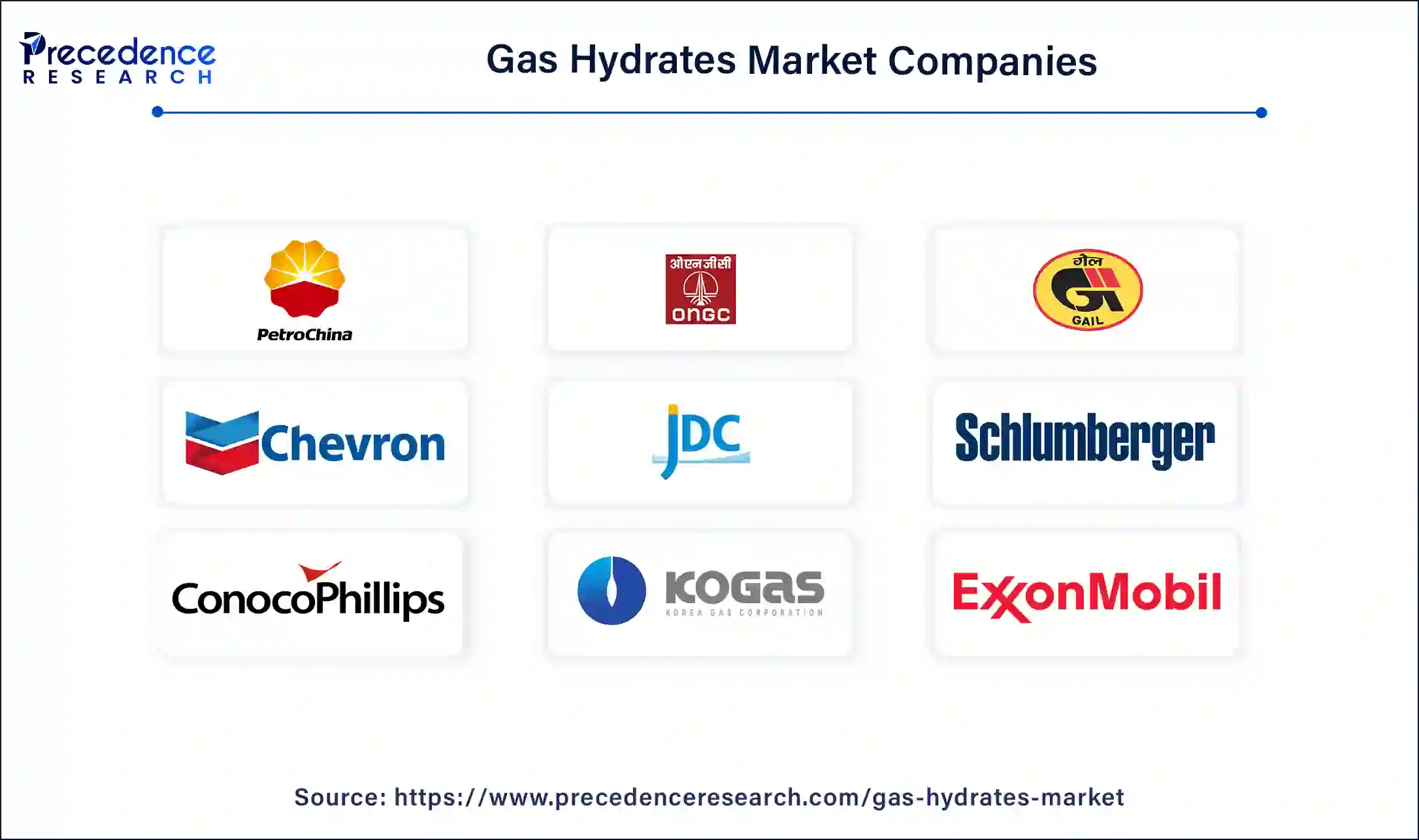List of Contents
Gas Hydrates Market Size and Forecast 2025 to 2034
The global gas hydrates market size was estimated at USD 2.56 billion in 2024 and is predicted to increase from USD 2.68 billion in 2025 to approximately USD 4.1 billion by 2034, expanding at a CAGR of 4.82% from 2025 to 2034. Factors such as the demand for natural gas, technological advancement in extraction systems, and focus on alternative energy sources are driving the growth of the gas hydrants market.

Gas Hydrates Market Key Takeaways
- In terms of revenue, the global gas hydrates market was valued at USD 2.56 billion in 2024.
- It is projected to reach USD 4.1 billion by 2034.
- The market is expected to grow at a CAGR of 4.82% from 2025 to 2034.
- Asia Pacific dominated the global market with the largest market share of 46% in 2024.
- North America is expected to witness the fastest growth during the forecast period.
- By type, the offshore/ marine gas hydrates segment contributed the highest market share of 64% in 2024.
- By type, the onshore gas hydrates segment is expected to grow fastest during the forecast period.
- By origin, the permafrost segment captured the biggest market share in 2024.
- By origin, the seabed segment is anticipated to grow significantly during the forecast period.
How is Artificial Intelligence (AI) Changing the Gas Hydrates Market?
The application of artificial intelligence (AI) in the gas hydrates market has revolutionized exploration, extraction, and safety-related activities. AI improves exploration by employing complex computing methods to identify areas with the potential for containing the resource in the form of gas hydrate at a lower cost. In these techniques, like depressurization and heating methods, AI makes it safer and more efficient as it takes data in real-time. Moreover, AI helps to manage such risks effectively and control emissions of greenhouse gases, such as methane. The application of artificial intelligence technology for management of natural gas hydrate in operating oil and gas pipelines.
Asia Pacific Gas Hydrates Market Size and Growth 2024 to 2034
The Asia Pacific gas hydrates market size was exhibited at USD 1.15 billion in 2024 and is expected to be worth around USD 1.91 billion by 2034, growing at a CAGR of 5.20% from 2025 to 2034.

Asia Pacific dominated the global gas hydrates market in 2024 due to the increase in the rate of production capacity and the Industrialization within the region. The high revenue control is the result of enhanced demands for energy consumption in countries such as China, India, and Japan. This region witnesses a relatively high level of capital investment in exploration as well as extraction techniques. In Japan, the gas hydrates occur in waters surrounding the country, including the Pacific side and the Sea of Japan. India yields one-third of the national oil necessity. Reduction of fossil fuels, growing crude oil prices, rising demand for clean energy, and uncertain supply tied with the geopolitical scenario demand an exploration for an alternative source of energy for sustainable improvement of an energy-starving.

North America is projected to host the fastest-growing gas hydrates market in 2023. The United States and Canada are enhancing extraction technologies and investing most of the research and exploration efforts. As evident from the region's natural gas network, these structures foster these developments, while the government's search for other energy sources creates an appropriate atmosphere. Massive deposits of gas hydrate are found in the region, with the Gulf of Mexico and Arctic having reserves.
Market Overview
Gas hydrates are a crystalline solid that consists of water and gas. Gas hydrates are formed by cage-like structures of water molecules that entrap molecules of natural gas. The chief constituent of natural gas is methane. These take place at high pressure and low temperature. Gas hydrates are also feasible when it comes to the storage of large volumes of large gas. Specifically, gas hydrates are stable and safe in case they are applied to appropriate exogenous geological formations. Methane hydrate can be a primary product that generates both biogenic, through the bacterially generated activity of the sea bed sediment, and thermo-genic, through geochemical activity deeper in the earth.
The gas hydrates market is gaining statutory recognition as an effective form of energy that is renewable and growing in several markets and energy-generating fields. The major components of gas hydrates include methane, which is well-used for the generation of electrical energy, manufacturing of urea fertilizer, room heating, cooking, and many other requirements.
Gas Hydrates Market Growth Factors
- Increasing energy demand: Higher energy demand, especially in developing countries, is encouraging the search for new energy sources such as gas hydrates.
- Energy security and diversification: Strive to move away from the traditional sources of energy, such that energy security is improved and gas hydrates are a viable source of energy.
- Cleaner energy source: Methane obtained from gas hydrates is cleaner than burning coal and oil and supports the reduction of emissions of greenhouse gases.
- Government support and research funding: Developing technologies for exploration and extraction through more investments by governments and other research institutions to explore the gas hydrates.
Market Scope
| Report Coverage | Details |
| Market Size by 2034 | USD 4.10 Billion |
| Market Size in 2024 | USD 2.56 Billion |
| Market Size in 2025 | USD 2.68 Billion |
| Market Growth Rate from 2025 to 2034 | CAGR of 4.82% |
| Largest Market | Asia Pacific |
| Base Year | 2024 |
| Forecast Period | 2025 to 2034 |
| Segments Covered | Type, Origin, and Regions |
| Regions Covered | North America, Europe, Asia-Pacific, Latin America and Middle East, and Africa |
Market Dynamics
Driver
Development of advanced extraction technologies
The driver for the growth of the gas hydrates market is the rise in investment in exploration and extraction all across the world. The decrease in fossil fuel and other governmental measures for the exploration of gas hydrates is the driving factor for the market growth. Continuous introduction of new technologies in the extraction process in the market.
Through research and technology development, it aims to enhance the yield rates as well as the economic feasibility of the extraction techniques using decompression techniques, thermal stimulation, and CO2 injection. The rise in the number of natural gas extraction activities has boosted the gas hydrates market progress. An increase in the population that necessitates energy consumption is a major driver of the market.
Restraint
Safety concerns and high cost of production
Gas hydrates cause safety concerns due to the risk of methane leakage during their extraction, as well as environmental concerns because methane is one of the most powerful greenhouse gases. Heavy, commercially exploited gas hydrates, when released into the environment, endanger both marine life and coastal people, as well as economic and structural investment. The gas hydrates market may also lead to an increase in the rate of global warming in the environment.
Furthermore, the high cost of extraction machinery and the complexities involved in the process used for purifying gas hydrates are two factors that can hamper the gas hydrates market growth. The operation and production of gas hydrates involve the utilization of advanced technology and hence experience high capital costs and operational costs.
Opportunity
Rising demand for clean and renewable energy
Natural gas hydrates are a natural part of the world's carbon cycle. Methane comes as the third most emitted greenhouse gas in the atmosphere apart from water. Changes in the global energy markets, primarily due to the increasing interest in cleaner hydrocarbon resources, have increased interest. With the increasing global drive towards carbon neutrality, the use of carbon capture and storage (CCS) integrated with gas hydrate extraction offers profitable options for lowering emissions of greenhouse gases. This potential makes the gas hydrates market a very promising reserve in the energy industry for those nations that are searching for reserves and seeking to decrease levels of emissions of greenhouse gases.
Type Insights
The offshore/ marine gas hydrates segment held the largest share of the gas hydrates market in 2024. Gas hydrates are substances in the form of ice and are found in collecting structural frameworks offshore and beneath permafrost. They are also referred to as marine gas hydrates. These are mainly found on the continental shelves in marine sediments in a several hundred meters thick layer just beneath the seabed. Offshore/Marine Gas Hydrates have received a boost from the continued strategic escalation of the construction ofoffshore drilling activities, particularly in areas with huge untapped Methane Hydrate reserves. Marine/gas hydrates present off-shore can be harvested in huge quantities by employing a deep sea recovery process and are employed in transportation & for power in commercial and industrial uses extensively. Despite this, a very large marine gas hydrate reservoir is viewed as continuing to play an important role in the global carbon cycle and a future energy resource.

The onshore gas hydrates segment is expected to grow fastest in the gas hydrates market over the forecast period. Gas hydrates are defined as icy solids that are created where water and gas react at low temperatures and high pressures onshore and offshore in large quantities. This continues to be a prospect for further study and development of efficient and environmentally friendly extraction techniques. These efforts are catalyzed by the need to shift the use of cleaner energy and decrease carbon footprints. A shifting focus in both segments projects the continued growth of technological innovations.
Origin Insights
The permafrost segment dominated the gas hydrates market in 2024. Gas hydrate deposits are located wherever methane is available in the presence of water under pressure and at temperatures not exceeding 5-15 °C, and usually at particular locations, including beneath permafrost or in shallow layers of the sea floor in the regions of deep seas. Permafrost gas hydrates are also widespread in arctic and subarctic areas, but they are more problematic for extraction because of environmental and especially geographical conditions. Gas hydrates are solid formations that are similar in structure to ice, which are formed from water and gas under pressure and moderate temperature.
The seabed segment is anticipated to grow significantly in the gas hydrates market during the forecast period. The occurrence of gas hydrates in the seabed has placed this origin segment as a crucial resource, driven by technological progressions that have made exploration and extraction more feasible. Gas hydrates are the solid structures that form on the seafloor when water and low-density gases such as methane, ethane, or carbon dioxide combine to form a structure that resembles ice. Several countries are going a long way toward ensuring that the seabed is free from methane hydrate.
Gas Hydrates Market Companies

- Petro China Company Limited (China)
- Japan Petroleum Exploration Company Limited (Japan)
- Oil and Natural Gas Corporation (India)
- Gail Limited (India)
- Chevron Corporation (U.S.)
- Japan Drilling Co., Ltd. (Japan)
- Schlumberger Limited (U.S.)
- ConocoPhillips (U.S.)
- Korea Gas Corporation (KOGAS) (South Korea)
- ExxonMobil Corporation (U.S.)
Latest Key Players Announcement
- A scientific drilling mission in the Gulf of Mexico in January 2024 recovered a methane hydrate reservoir situated beneath the sea bed. Methane hydrates are rich in energy globally and hold approximately 15% of the world's organic carbon, though little is known by the scientific community. The successful mission, spearheaded by the University of Texas, will now enable universities and scientific institutions across the country to get their hands on methane hydrates.
Recent Developments
- In October 2023, the National Energy Technology Laboratory (NETL) of the U.S. Department of Energy (DOE) disclosed that it is studying gas hydrate resources within the Prudhoe Bay Unit of Alaska's North Slope.
- In January 2023, China unveiled that it was willing to drill a third gas hydrate well in the South China Sea further. Additional preceding exploration and evaluation activities are required before commercial development in 2030.
- In December 2022, an expedition sponsored by the National Energy Engineering Laboratory, which belongs to the U.S. Department of Energy and the Japan Organization for Metals and Energy Security, drilled well over 600 meters or 2000 ft of permafrost to extract hydrate-bearing sediments that were deep within the tundra plateaus and basins.
Segments Covered in the Report
By Type
- Onshore Gas Hydrates
- Offshore/Marine Gas Hydrates
By Origin
- Seabed
- Permafrost
By Geography
- North America
- Asia Pacific
- Europe
- Latin America
- Middle East and Africa
For inquiries regarding discounts, bulk purchases, or customization requests, please contact us at sales@precedenceresearch.com
Frequently Asked Questions
Ask For Sample
No cookie-cutter, only authentic analysis – take the 1st step to become a Precedence Research client